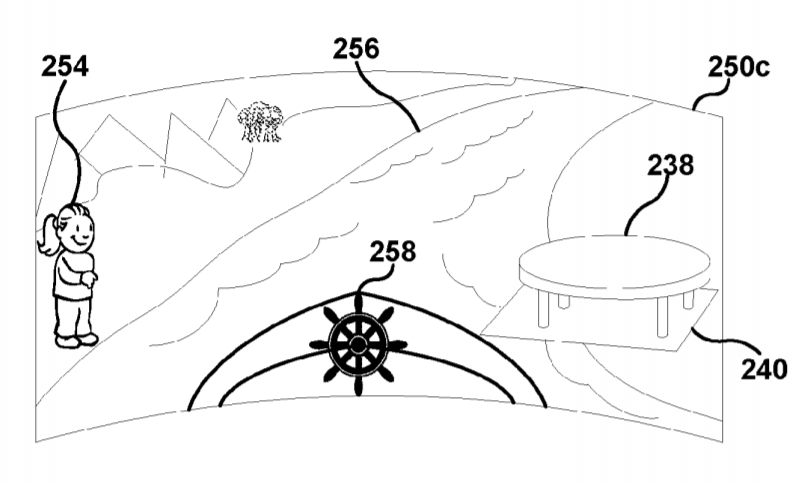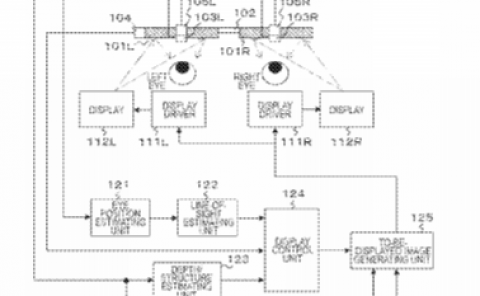Sony Patent | Augmenting virtual reality content with real world content
Patent: Augmenting virtual reality content with real world content
Publication Number: 10191541
Publication Date: 2019-01-29
Applicants: Sony

Abstract
Methods, devices, and computer programs for augmenting a virtual reality scene with real world content are provided. One example method includes an operation for obtaining sensor data from an HMD of a user to determine that a criteria is met to overlay one or more real world objects into the virtual reality scene to provide an augmented virtual reality scene. In certain examples, the criteria corresponds to predetermined indicators suggestive of disorientation of a user when wearing the HMD and being presented a virtual reality scene. In certain other examples, the one or more real world objects are selected based on their effectiveness at reorienting a disoriented user.
Background
Virtual reality (VR) is becoming more and more pervasive as a way for consumers to interact with content and as a way for content creators to interact with an audience. As the popularity of VR continues to grow, so does its level of intensity and immersion. It is not uncommon for virtual reality scenes (VRS) to cause disorientation in a viewer. The level of disorientation can range from mild discomfort to severe unpleasantness. As a result, disorientation is a concern from both a usability context as well as one of safety. For example, disorientation causes overall user experience to suffer and takes away from a VR experience. Moreover, the potential for user disorientation may restrict what content creators are willing to produce out of concern for preventing potentially disorienting scenes.
Thus, as VR immersiveness and intensity continues to grow, there are advantages to systems and methods that can provide measures to alleviate disorientation and/or discomfort they may cause.
It is in this context that embodiments of the invention arise.
Summary
Embodiments of the present invention provide methods and systems for changing virtual reality scenes, and more particularly, for augmenting virtual reality scenes with real world content. The method and system also define embodiments for switching between VR content and real-world content, and managing transitions between the two. It should be appreciated that the present invention can be implemented in numerous ways, such as a process, an apparatus, a system, a device or a method on a computer readable medium. Several inventive embodiments of the present invention are described below.
In one embodiment, a method includes an operation for obtaining data from sensors on an HMD. Sensor data is processed to determine whether a first criteria is met to transition from a virtual reality scene (VRS) to an augmented VRS to be displayed on the HMD, wherein the first criteria corresponds to predetermined indicators suggestive of disorientation of a user when wearing the HMD and being presented the VRS. Once it is determined that the first criteria is met, the method includes an operation for inserting a first real world object into the VRS to produce an augmented VRS, where the first real world object is from a real world view provided by a camera disposed in a virtual reality interactive space. “Augmented VRS” or “augmented VR” in the context of these embodiments refer to VR that has been modified from an original state to include content from the real world. Augmented VR or VRS may also be referred to as a “hybrid view” or “hybrid HMD view.”
In another embodiment, a system for providing VRS includes a process for obtaining sensor data from an HMD. The system also includes a processor that processes said data to determine whether a first criteria is met. The first criteria corresponds to predetermined indicators suggestive of disorientation of a user when wearing the HMD and being presented the VRS. The system further includes rendering components that insert a real world object into the VRS. The real world object is capture from a real world view provided by a camera disposed in the virtual reality interactive space.
In yet another embodiment, a computer program embedded in a non-transitory computer-readable storage medium, when executed by one or more processors, changes virtual reality content of an HMD. Included in the medium are program instructions for obtaining HMD sensor data and processing said data to determine that a first criteria is met, the first criteria corresponding to predetermined indicators that are suggestive of disorientation of a user when wearing the HMD and being presented the virtual reality scene. Further, the medium also includes program instructions for inserting a first real world object into the VRS, the first real world object being from a real world view provided by a camera in a virtual reality interactive space.
Other aspects of the invention will become apparent from the following detailed description, taken in conjunction with the accompanying drawings, illustrating by way of example the principles of the invention.


